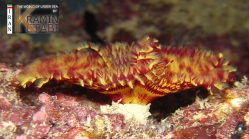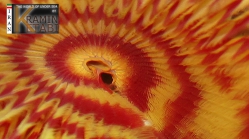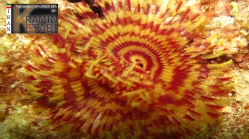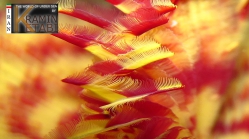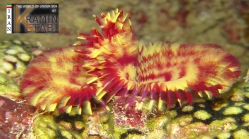
| About | | Search taxa | | Taxon tree | | Search literature | | Specimens | | Distribution | | Checklist | | Stats | | Log in |
Polychaeta taxon detailsSabellastarte Krøyer, 1856
206071 (urn:lsid:marinespecies.org:taxname:206071)
accepted
Genus
Sabella indica Savigny, 1822 accepted as Sabellastarte spectabilis (Grube, 1878) (type by subsequent designation)
Paralaonome Bush, 1904 · unaccepted (subjective synonym)
marine,
recent only
Kröyer, Henrik. (1856). Afhandling om Ormeslaegten <i>Sabella</i> Linn., isaer med Hensyn til dens nordiske Arter [Alternate title: Bidrag til Kundskab af Sabellerne]. <em>Oversigt over det Kongelige danske Videnskabernes Selskabs Forhandlinger.</em> 1856: 1-36., available online at https://www.biodiversitylibrary.org/page/40359509
page(s): 13 [details]
Note Type species Sabella indica Savigny, 1822,...
From editor or global species database
Type species Type species Sabella indica Savigny, 1822, junior primary homonym to Sabella indica Gmelin, a pectinariid. The valid name Sabella spectabilis (Grube, 1878) (now Sabellastarte) is the next available synonym, but Sabella indica Savigny remains the type species (Article 67.1.2) although permanently invalid. See Knight-Jones & Mackie (2003:2272) for nomenclature history. [details]
Taxonomy Savigny (1822) created a "tribu' subdivision called 'Sabellae Astartae' within genus Sabella. Knight-Jones and Mackie...
Taxonomy Savigny (1822) created a "tribu' subdivision called 'Sabellae Astartae' within genus Sabella. Knight-Jones and Mackie (2003) state that: “Although Krøyer (1856: 13) was the first to regularize Savigny’s (1822) tribe Sabellae Astartae to [genus] Sabellastarte, he added nothing to its diagnosis. Grube (1870: 340) was the first to suggest that the crown radioles, described by Savigny as arising in ‘two equal parallel rows’, actually constituted ‘a single row directed alternately to the outside and the inside’ (here termed interdigitated). He also added a character, ‘thoracic tori with a single row of hooks’ (i.e. companion chaetae absent).” [details]
Read, G.; Fauchald, K. (Ed.) (2021). World Polychaeta database. Sabellastarte Krøyer, 1856. Accessed at: http://www.marinespecies.org/polychaeta/aphia.php?p=taxdetails&id=206071 on 2024-04-19
Date action by 2006-09-28 06:51:36Z changed Martinez, Olga
original description
Kröyer, Henrik. (1856). Afhandling om Ormeslaegten <i>Sabella</i> Linn., isaer med Hensyn til dens nordiske Arter [Alternate title: Bidrag til Kundskab af Sabellerne]. <em>Oversigt over det Kongelige danske Videnskabernes Selskabs Forhandlinger.</em> 1856: 1-36., available online at https://www.biodiversitylibrary.org/page/40359509
page(s): 13 [details] original description (of Paralaonome Bush, 1904) Bush, K.J. (1904 (1905)). Tubicolous annelids of the tribes Sabellides and Serpulides from the Pacific Ocean. <em>Harriman Alaska Expedition.</em> 12: 169-346, plates XXI-XLIV., available online at https://www.biodiversitylibrary.org/page/22063650 page(s): 197; note: New genus for Laonome japonica Marenzeller 1884 [details] basis of record Day, J. H. (1967). [Sedentaria] A monograph on the Polychaeta of Southern Africa. Part 2. Sedentaria. British Museum (Natural History), London. pp. 459–842., available online at http://www.biodiversitylibrary.org/bibliography/8596 [details] additional source Capa, María; Bybee, David ; Bybee, Seth. 2010. Establishing species and species boundaries in Sabellastarte Krøyer, 1856 (Annelida: Sabellidae): an integrative approach. Organisms Diversity & Evolution 10(5): 351-371. [details] additional source Capa, Maria; Murray, Anna. (2015). A taxonomic guide to the fanworms (Sabellidae, Annelida) of Lizard Island, Great Barrier Reef, Australia, including new species and new records. <em>Zootaxa.</em> 4019(1): 98-167., available online at https://doi.org/10.11646/zootaxa.4019.1.8 page(s): 151, Fig. 22A–D; note: Possible undescribed species record for Lizard Island [details] Available for editors additional source Neave, Sheffield Airey. (1939-1996). Nomenclator Zoologicus vol. 1-10 Online. <em>[Online Nomenclator Zoologicus at Checklistbank. Ubio link has gone].</em> , available online at https://www.checklistbank.org/dataset/126539/about [details] status source Knight-Jones, Phyllis and Mackie, Andrew S. Y. 2003. A revision of Sabellastarte (Polychaete: Sabellidae). Journal of Natural History, 37(19): 2269-2301., available online at https://doi.org/10.1080/00222930110120629 [details] From editor or global species database
Taxonomy Savigny (1822) created a "tribu' subdivision called 'Sabellae Astartae' within genus Sabella. Knight-Jones and Mackie (2003) state that: “Although Krøyer (1856: 13) was the first to regularize Savigny’s (1822) tribe Sabellae Astartae to [genus] Sabellastarte, he added nothing to its diagnosis. Grube (1870: 340) was the first to suggest that the crown radioles, described by Savigny as arising in ‘two equal parallel rows’, actually constituted ‘a single row directed alternately to the outside and the inside’ (here termed interdigitated). He also added a character, ‘thoracic tori with a single row of hooks’ (i.e. companion chaetae absent).” [details]Type species Type species Sabella indica Savigny, 1822, junior primary homonym to Sabella indica Gmelin, a pectinariid. The valid name Sabella spectabilis (Grube, 1878) (now Sabellastarte) is the next available synonym, but Sabella indica Savigny remains the type species (Article 67.1.2) although permanently invalid. See Knight-Jones & Mackie (2003:2272) for nomenclature history. [details] |
